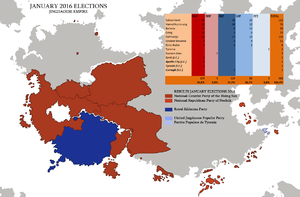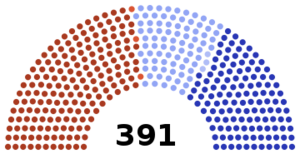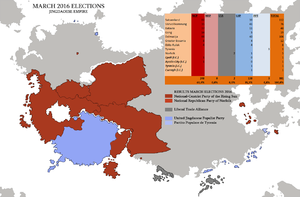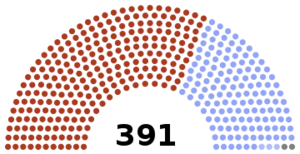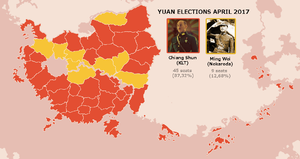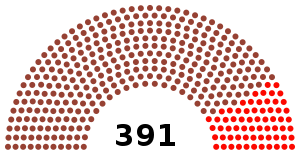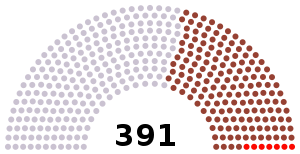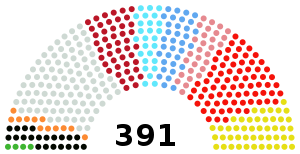Imperial Yuan
The Chidao Emperor Imperial Household | Imperial Stewardship Teachings of the Empire
Ministries & Secretariats: Ministry of Truth | Ministry of Purity | Ministry of Stability Chao Suweiai formerly known as National Diet Defunct:
Political Factions: Guanchang | Kantai-ha (Navy) | Gunbatsu (Army) | Shanghu (Traders) Defunct: Other institutions Tianchao Chuandui | Imperial Armed Forces | Young Wandering Society | Tegong |
The Imperial Yuan is the lower house of the National Diet of Jingdao. The Seanad is its upper house.
The Yuan has 54 members, elected for a 90-ASC year term (three months). Each District has one seat, which grants a certain advantage to the rural Provinces with more districts. 28 seats are required for a majority. The predecessor of the lower house was the Imperial Assembly.
History as Imperial Assembly
The Imperial Assembly was the elective and legislative chamber of the Jingdaoese Empire during the Minshu Period. Elections were planned to be held every 15 daor (3 AN Years).
The Assembly came into power with the ascension of the Zettai Emperor to the Throne in 1631 AN. Original plans to establish it as a strong, independent legislative institution with more or the same amount of power as the Emperor were soon thwarted, after heavy protests of ultranationalists. This kind of limited constitutional democracy (for Jingdaoese standards still enormous) led to it being called the Minshu Period. The 1634 Elections even saw a landslide victory for the National-Centrist Party of the Rising Sun, with an election program which would further strengthen imperial power.
With the Sheng Restoration in 1640 AN, the Assembly stopped functioning. Criticism on the institution existed since its beginning: ultranationalists saw in it the decline of old fashioned standards, while progressives called it a rubber stamp institution. The result was that two factions tried - directly or indirectly - to undermine its existence and power. It would take until 1647 AN that new elections, now for a reformed Yuan, would take place.
History as Imperial Yuan
The Xianfa Constitution introduced a reformed legislative chamber which replaced the now defunct Assembly. The Imperial Yuan, now endorsed by the Xianfa Emperor to quell the worst excesses of socialist agitation, was a success in terms of limiting a take over by progressives. It, however, gave men like Ming Wei and his Nokarodo Faction a place to express their ideology. When Ming Wei died in suspicious circumstances during the first year of the Hai Emperor's reign, this resulted in a heavy backlash. The outbreak of rebellion in the poorer, northern districts around Lake Christoph (the Xianbei Defiance) resulted in a crackdown on the socialist movements.
With most socialists in jail for supporting (or being perceived of having supported) a rebellion against the Imperial Household, new elections were held. The traditional Kuominliantang and Nokarodo Faction were swept away by the Badao Party, which under leadership of the Second Princess Yuling (and sister of the Hai Emperor) tried to strengthen imperial power.
With the outbreak of the war elections were put on hold, as the survival of the Realm prevailed. The war, especially among the millions of young people who were send to the fronts or factories, influenced many to rethink the existing political system. The mutinies in 1656 on the Dalmacijan front placed the Hai Emperor - and later the Meiyo Emperor - for new challenges and pushed the Jingdaoese elite further towards favouring stronger ties with its economical strong ally, Passio-Corum, and eventually establishing the Bassarid Federation.
Elections
1632 Assembly
| Party logo | Party name | Leader | Ideology | Colours | % of the total votes | % of the total seats | Seat change | Seats in 1632 |
|---|---|---|---|---|---|---|---|---|
| National-Centrist Party of the Rising Sun | Alexander Myksos | Jingdaoese Nationalism, market centralism | Dark red | 41,52% | 45,8% | New |
179 / 391 | |
| File:KRP logo.png | Royal Kildarian Party | Theodosius Myksos | Regionalism, monarchism | Dark blue | 28,34% | 32,0% | New |
129 / 391 |
| United Jingdaoese Populist Party | Lorenzo di Focanzo Montini | Regionalism, Big Tent | Light blue | 18,31% | 20,7% | New |
81 / 391 | |
| National Republican Party of Norfolk | Franklin Ross | Jingdaoese Nationalism, protectionism, militarism | Red | 6,70% | 0,8% | New |
3 / 391 | |
| Partito Populare de Tyrenia | Giacomo Contarini | Regionalism, Big Tent | Light blue | 5,13% | 0,8% | New |
3 / 391 |
1634 Assembly Elections
1647 Yuan Elections
| Party logo | Party name | Leader | Ideology | Colours | % of the total votes | % of the total seats | Seat change | Seats in 1647 |
|---|---|---|---|---|---|---|---|---|

|
Kuominliantang | Chiang Shun | Jingdaoese Nationalism, militarism, Emperor Worship | Dark red | 87,32% | 83,33% | +77 |
325 / 391 |

|
Nokarodo Faction | Ming Wei | Jingdaoese Nationalism, socialism | Red and yellow | 12,68% | 16,67% | +65 |
65 / 391 |
1650 Yuan Elections
| Party logo | Party name | Leader | Ideology | Colours | % of the total votes | % of the total seats | Seat change | Seats in 1650 |
|---|---|---|---|---|---|---|---|---|

|
Badao Party | Second Princess Yuling | Jingdaoese Nationalism, Emperor Worship,
restoration of Imperial Power |
Silver | 57,41% | +221 |
221 / 391 | |

|
Kuominliantang | Chiang Shun | Jingdaoese Nationalism, militarism, Emperor Worship | Dark red | 40,74% | -89 |
159 / 391 | |

|
Nokarodo Faction | Tsukono Wei | Socialism, republicanism | Red and yellow | 1,85% | -58 |
7 / 391 |
1657 Yuan Elections
| Party logo | Party name | Leader | Ideology | Colours | % of the total votes | % of the total seats | Seat change | Seats in 1657 |
|---|---|---|---|---|---|---|---|---|

|
Badao Party | Tzao Yao, Field Marshall | Jingdaoese Nationalism, Emperor Worship,
restoration of Imperial Power |
Silver | 25,10% | -123 |
98 / 391 | |

|
Nokarodo Faction | Tsukono Wei | Socialism, republicanism | Red and yellow | 18,9% | +67 |
74 / 391 | |
| File:Kyosanto Union.png | Kyosanto Union | Yamato Wei | Communism, republicanism | Yellow | 12,02% | +47 |
47 / 391 | |

|
Kuominliantang | Masaaki Yamazaki | Jingdaoese Nationalism, militarism, Emperor Worship | Dark red | 11,77% | -113 |
46 / 391 | |
| File:Jiyuto.png | Jiyuto Alliance | Shinzo Nikai | Liberalism | Blue | 8,70% | +34 |
34 / 391 | |
| File:Guoji Party.png | Guoji Party | Seiko Abe | Social democrats, internationalism, pro-Kildarian autonomy | Pink | 7,41% | +29 |
29 / 391 | |
| File:Aikokusha Society.png | Aikokusha Society | Militarism, patriotism, liberalism | Light blue | 6,65% | +26 |
26 / 391 | ||
| File:Tohokai.png | Tohokai | Fascism, expansionism, ethnic segregation | Black | 5,38% | +21 |
21 / 391 | ||
| File:Harmonious Centrist Party.png | Harmonious Centrist Party | Centrism, Emperor Worship, conservatism | Orange | 3,07% | +12 |
12 / 391 | ||

|
Yuanist Revival Association | Reactionary, Windsorist movement seeking to place a yuanist on the Throne | Green | 1,02% | +4 |
4 / 391 |



